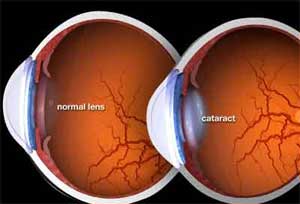- Home
- Editorial
- News
- Practice Guidelines
- Anesthesiology Guidelines
- Cancer Guidelines
- Cardiac Sciences Guidelines
- Critical Care Guidelines
- Dentistry Guidelines
- Dermatology Guidelines
- Diabetes and Endo Guidelines
- Diagnostics Guidelines
- ENT Guidelines
- Featured Practice Guidelines
- Gastroenterology Guidelines
- Geriatrics Guidelines
- Medicine Guidelines
- Nephrology Guidelines
- Neurosciences Guidelines
- Obs and Gynae Guidelines
- Ophthalmology Guidelines
- Orthopaedics Guidelines
- Paediatrics Guidelines
- Psychiatry Guidelines
- Pulmonology Guidelines
- Radiology Guidelines
- Surgery Guidelines
- Urology Guidelines
Diabetics twice more prone to develop cataract

Researchers from UK analysed medical records of 56,510 patients of dabetes and have concluded that Diabetics are twice more prone to develop cataract as compared to general population and the relative risk is highest in those aged between 45 and 54.Their findings have been published in the journal Eye.
Diabetics aged between 45 and 54 were considerably more likely than non-sufferers to develop cataract. Those diabetic patients aged between 45 and 49 were 4.6 times more likely to, and diabetics aged between 50 and 54 were 5.7 times more at risk than their healthy counterparts.Researchers analysed medical records from 56,510 UK-based diabetes patients aged 40 or over and found that cataract was diagnosed at an overall rate of 20.4 per 1,000 people. This compares to a rate in the general population of 10.8 per 1,000.
The study used data from the Clinical Practice Research Datalink, which covers around 7% of the UK population and is representative of the overall demographic with regard to age, sex and geographic distribution.
Cataract is one of the main causes of global sight loss. In a previous study by the Vision Loss Expert Group, it was revealed that the condition accounted for significant vision loss or blindness in 65million people worldwide.
Co-author Rupert Bourne, Professor of Ophthalmology at Anglia Ruskin University's Vision and Eye Research Unit, said: "The report has shown that having diabetes doubles your risk of being diagnosed with a cataract, and that this risk is six times higher if a diabetic patient has significant diabetic retinal disease, called diabetic maculopathy.
"This is only the second such report on cataract incidence in the UK's diabetic patients since the 1980s and it further emphasises the importance of the NHS Diabetic Eye Screening programme in early identification and treatment of diabetic eye disease to prevent sight loss.
"This is an interesting example of how a very large primary care dataset of electronic patient data, in this case the Clinical Practice Research Datalink, can be used to investigate risk factors for eye disease."
For more details click on the link: http://dx.doi.org/10.1038/s41433-017-0003-1

Disclaimer: This site is primarily intended for healthcare professionals. Any content/information on this website does not replace the advice of medical and/or health professionals and should not be construed as medical/diagnostic advice/endorsement or prescription. Use of this site is subject to our terms of use, privacy policy, advertisement policy. © 2020 Minerva Medical Treatment Pvt Ltd